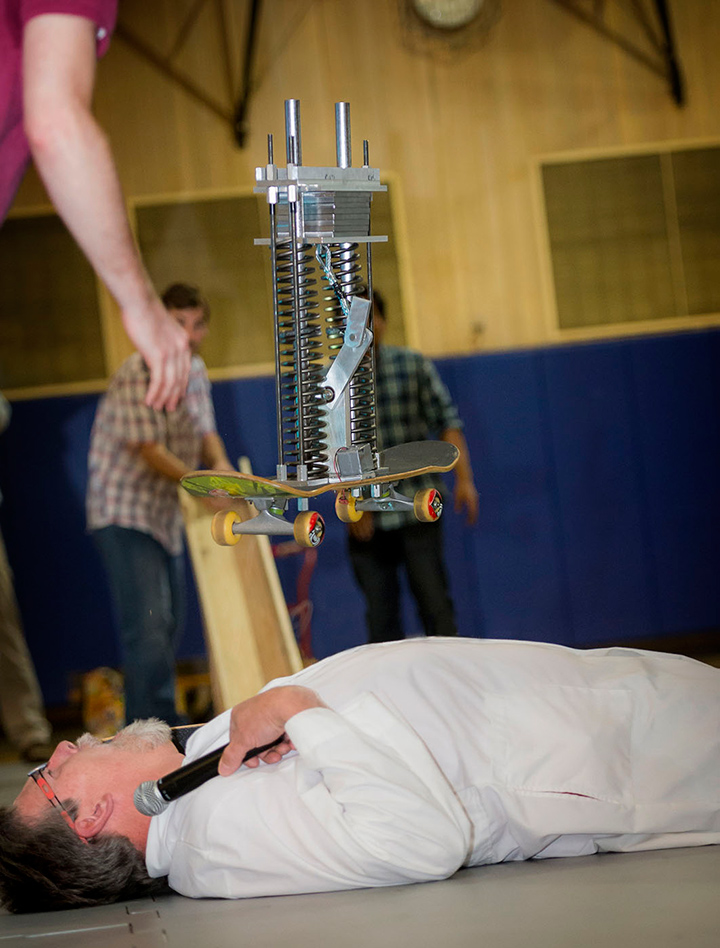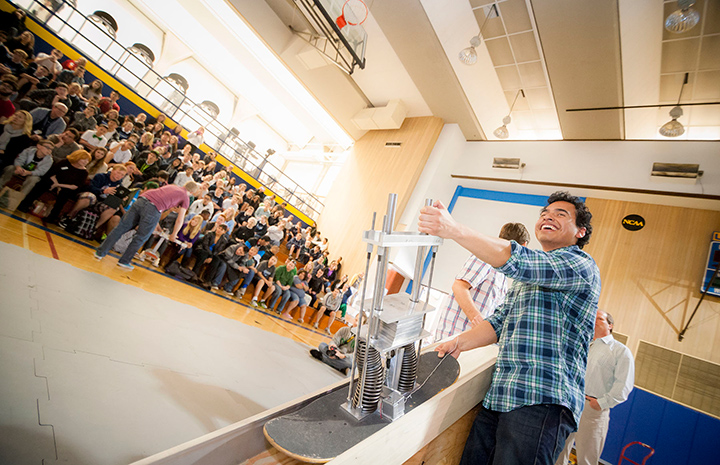Could a Robotic Skateboard Defeat Tony Hawk? One Day, Maybe
Engineering Students Teach Children About the Physics of Skateboarding
By:
- Ioana Patringenaru
Published Date
By:
- Ioana Patringenaru
Share This:
Article Content
“Five! Four! Three! Two! One!” A robotic skateboard soared high into the air and above Paul Schmitt, a scientist and skateboard designer, then landed with a thud on the floor of the Main Gym on the UC San Diego campus on Monday, March 18.
It was all part of a San Diego Science and Engineering Festival event designed to show that science is cool. The robotic skateboard was created by a team of UC San Diego seniors studying mechanical engineering. They had to understand the physics of skateboarding, design the robot, run simulations that would predict how it would perform and build it. The project is part of the capstone design course for the Department of Mechanical and Aerospace Engineering at UC San Diego.
Students worked with Raymond de Callafon and Nate Delson, two faculty members at the Jacobs School of Engineering. They partnered for outreach events with Schmitt, who is well known in skateboarding circles.
“Engineering is not boring,” David Quintanilla, fifth-year student, told children, parents and teachers who turned out for the event. “Engineers are not nerds!”

The robotic skateboard sails over Paul Schmitt, a scientist and skateboard designer. Photos by Erik Jepsen/UC San Diego Publications
The robotic skateboard sails over Paul Schmitt, a scientist and skateboard designer.
The robot is basically a skateboard outfitted with two springs, which stand in for a skateboarder’s legs. Students compress the springs with a car jack. Then a mechanism releases the springs, which apply about 500 pounds of force to the skateboard and make it jump.
The Jacobs School students went on to demonstrate two important concepts that allow their robot to work. One is conservation of energy, which transfers the energy from the springs to the skateboard, making it jump. The other is conservation of momentum, which depends on an object’s mass and velocity. The bigger the velocity and mass, the bigger the momentum.
After the demonstration, Cathy Etchechury, a fifth-grader in Chula Vista, said she plans to build robots and create computer animations when she grows up. “It was really good,” she said when asked about the event. “I learned about mass, physical sciences and robotics.”
The Jacobs School students taking part in the project said they had a lot of fun working together. “I love that it’s not just normal school work,” said Rachel Dittemore. “We’re hands on. We see our hard work pay off.” Everyone on the team contributed to data analysis, design and manufacturing, she said.
“What’s not to like?” said Quintanilla. “We’re working on skateboards. Skateboards are fun, and cool.” The project combines two things Quintanilla said he loves: skateboards and robotics. Like Dittemore, he also said he liked working with classmates to develop the robot.

David Quintanilla, a senior in mechanical engineering, demonstrates a robotic skateboard for an audience of about 400 at the Main Gym at UC San Diego March 18.
The team has also developed a robot that can move its mechanical arms up and down, much like skateboarders do and skate on a half-pipe. They also built smaller robotic skateboards that can be used by students in the classroom to learn about physics. These prototypes were tested by students at the Preuss School, a charter school for first-generation, low-income students on the UC San Diego campus. The other students involved in the project were Josh Harling, Jonny Ladner and Ryan Meeks.
BAE Systems and SPAWAR funded the project. Recently, money has been added to pay for a student who could work on the robotic skateboards year-round. The ultimate goal is to build a robot that can compete with a human skateboarder, said de Callafon.
“We’re trying to get children interested in science,” he said. “We have a combination of the right buzz words: robotics and skateboarding.”
Share This:
You May Also Like
Engineers Take a Closer Look at How a Plant Virus Primes the Immune System to Fight Cancer
Technology & EngineeringStay in the Know
Keep up with all the latest from UC San Diego. Subscribe to the newsletter today.



